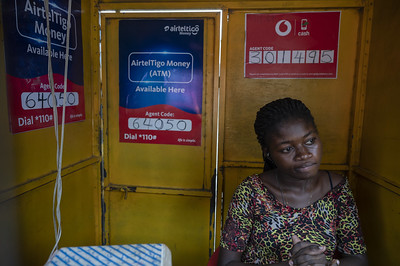Can earmarking provide an answer to the controversy of taxes on digital financial services such as Ghana’s e-levy? Although an unpopular policy tool, it may be a necessary evil.
“I would pay the e-levy and more if I could trust the money would help my country!” exclaimed a Ghanaian citizen, shortly after the e-levy was introduced in May 2022.
During a scoping exercise soon after the e-levy came into effect, and more recently from focus group discussions in March 2023 (currently undergoing analysis), preliminary evidence the DIGITAX research team has gathered indicates that this sentiment may not be uncommon.
That said, despite the Ghanaian government’s promises to fund several national development programmes such as infrastructure and transportation through the e-levy, many citizens are still sceptical. This earmarking, or setting aside revenue for a specific purpose, is not mentioned in the legislation, and current revenue from the e-levy is still pooled into overall government spending.
Ghana is not the first country to implement a tax on digital financial services (DFS), such as mobile money, which has led to controversy and widespread public dissent. For Ghana and other countries implementing DFS taxes perceived as controversial, this then raises the question: Is earmarking worth considering for DFS taxes?
What does earmarking for DFS taxes look like?
Tax earmarking refers to a transparent link between revenue collected from tax and how it is spent, also known as hypothecation or ringfencing. In this context, this means potentially setting aside revenue collected from taxes on DFS end consumers when transferring or withdrawing money digitally. For example, in Kenya, 16 per cent of the excise duty paid from money transfers on mobile phones is set aside to support social development such as universal health care.
Is earmarking popular?
Although the practice of earmarking tax revenue is not new, it has seen a resurge among policymakers in recent years, especially in the context of environmental and health taxes. The practice is quite controversial, with significant challenges in its design and implementation. Critics argue that earmarking could cause budget rigidity, economic distortion, fragmentation, and an inefficient allocation of funds. Additionally, it could bind future governments to specific funding allocations, limiting their flexibility and choice in spending.
The political nature of earmarking also raises questions about its effectiveness, with some considering it, at best, a meaningless policy palliative.
Given these limitations and drawbacks, why would a government consider including earmarking in its tax design? Proponents claim that earmarking increases transparency, accountability, and equity by targeting social objectives, especially for vulnerable groups, such as youth, women, people with disabilities, and the poor.
What does the evidence tell us about tax earmarking?
Evidence shows that the more information available about the benefits of a tax, the more willing the public is to pay it. A study in Mexico found that earmarking can increase political support for a tax in certain conditions. The study indicated that environments with either a lack of trust in the government, low income, or good perceptions of public services especially benefit from earmarking as a tool to increase support for a particular tax.
In the case of Ghana, the country has a history of ‘resolving’ controversial taxes accompanied by widespread public dissent through earmarking. The Ghana Education Fund (GET Fund) and National Health Insurance Scheme (NHIS) are examples of funds that received earmarked revenue from unpopular increases in value-added Taxes (VAT) as a compromise between the dissatisfied public and the government. Although the tax policy was set to roll out regardless, the decision to set aside funds was a political choice that led to more acceptance of the new tax policy while generating critical sources of revenue. The positive impact of these policies on public perception was evident when several individuals suggested ringfencing revenue, similar to the previously-mentioned examples, as a way to improve the e-levy design.
Although earmarking is perhaps not the most efficient way to allocate public funds, its merits lie in engaging the public in tax policy, and, as a result, it can be a short-term tool to enhance trust and accountability in tax collection and spending.
Why consider earmarking for consumer-level DFS taxes?
Mobile money has witnessed continuous growth in adoption and usage in many countries, making it an increasingly attractive space for potential revenue collection. As such, governments, especially in cash-strapped times, look towards mobile-money users to widen the tax net and collect revenue.
However, widespread protests are often not far behind the introduction of DFS taxes, which are perceived to be unfair and detrimental to financial inclusion, especially for vulnerable populations. The sensitive nature of mobile money may offer a strong entry point for governments to rebuild the trust often lacking in these contexts. Furthermore, DFS taxes apply to a technology with an alternative: most people can return to cash if they do not support the tax. So, having public support for these taxes is important for the continued use of mobile money and the revenue it can generate.
In these cases, linking the DFS taxes to well-regarded public services with earmarking may improve public perceptions of the tax, as well as the wider tax system and government, through increased accountability and transparency.
So, should governments earmark DFS taxes?
As DFS continue to grow in popularity and more governments look to tax digital transactions, understanding how to design effective and publicly accepted DFS taxes is crucial. If transparency and trust are not addressed, government revenue goals might not be met, and there may be longer-term negative perceptions of the government.
These taxes are particularly controversial, so earmarking to fund national services – while a less-than-ideal approach to tax design that should be used with caution – might be a necessary evil.
Links
- Webinars
- Blogposts
- Ghana’s e-levy is unfair to the poor and misses its revenue target: A lesson in mobile money tax design (March 2023)
- The Ghana e-levy: Can the latest rate reduction win greater public acceptance and increase revenue? (February 2023)
- Taxes on digital financial services in Africa – An unlevel playing field (February 2023)
- Identity issues: four challenges for digital IDs in Africa’s tax system (November 2022)
- Ghana’s new e-levy: the sour, sweet and switches so far (August 2022)
- Infographic: Taxation of digital financial services in Ghana – Who uses digital financial services in Ghana? How much do they use them? How are digital financial services taxed?



